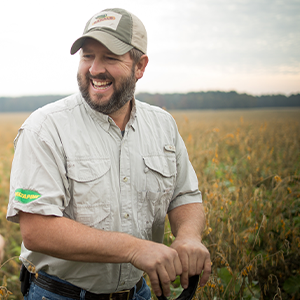Burton Heatwole

Farmer Mentor in 2019-20
Millen, Georgia
Burton Heatwole previously served as an SHI Farmer Mentor for Georgia. To see our current SHI Soil Health Educators, Technical Specialists, and Farmer Mentors who are located throughout the U.S. Cotton Belt, please visit our Contacts page.
Burton of Sunshine Place Farm near Millen, Georgia, learned about soil health as a child by watching his father plant cotton into a heavy cereal rye cover crop with a strip-till planter. While the purpose of the cover crop was primarily forage for the family dairy, the benefits to the cotton crop were obvious. By 2016, Burton started planting cotton again to help diversify his rotation that included peanuts. Today, he rotates between corn, wheat, soybeans, cotton and peanuts, and plants everything with a strip-till planter. In addition, Burton plants diverse cover crop mixes between all crops. He feels this system helps him take better care of his soils so that they can take care of him.
Soil Health Management System
Burton’s soil health management system addresses all four of the soil health principles that include maximizing diversity, minimizing disturbance, keeping living roots growing and maintaining residue cover. He accomplishes these principles through a diverse crop rotation that incorporates cover crops along with strip-till planting of all his crops. Burton places a lot of emphasis on increasing diversity and keeping living roots by planting cover crop mixes with 8 or more different species. In addition, Burton follows a nutrient management plan and controls pests using integrated pest management (IPM).
Reasons for adopting a soil health management system:
- Was tired of seeing soil leaving his field and those of his neighbors after spring rains;
- Wanted to find ways to make more money from the same acreage;
- Recognized the importance of soil biology in rejuvenating his soils, including the role of soil biology in nutrient and water cycling; and
- Wanted to increase soil organic matter and water infiltration.
Soil health benefits observed:
- Eliminated soil compaction by planting tillage radish, which resulted in a noticeable difference in how the tractor idled down when pulling subsoiler;
- Increased water infiltration, which he suspects was due to variation in rooting depths from cover crop mix;
- Increased plant available water after harvesting corn silage that allows cover crops to germinate and flourish;
- Increased presence of earthworms;
- Eliminated runoff leaving field with soil staying in place; and
- Darker colored soils in the top 2 to 3 inches, generally an indicator of increased soil organic matter.
Tips for fellow producers on adopting a soil health management system:
- Try new ideas on small plots every year—if you cannot afford to experiment on small plots then you cannot afford to be farming;
- Address the biggest compaction problem that farmers deal with in agriculture: the one between our ears, not in the soil;
- Realize that increasing soil organic matter comes through living roots and not just from growing tall cover crops;
- Take advantage of late summer and early fall sunlight by planting a multi-species cover crop to better trap sunlight, control weeds and improve nutrient cycling;
- Keep a living root growing year-round, which can be accomplished when farming in the Southeastern United States; and
- Recognize the unintended consequences that farming activities have on the soil ecosystem.
Moving forward, Burton will continue to improve his soil health management system by:
- Integrating more grazing summer cover crops, as most of what a cow eats is returned to the field through manure and urine;
- Moving into a no-till system by eliminating strip-till and recognizing the impact that even a minimal amount of disturbance has on soil health;
- Managing cover crops to control moisture in extreme weather events including drought or deluge; and
- Reducing farm inputs and equipment to be more successful in the future.